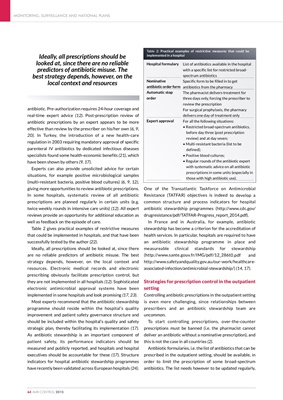
antibiotic. Pre-authorization requires 24-hour coverage and
real-time expert advice (12). Post-prescription review of
antibiotic prescriptions by an expert appears to be more
effective than review by the prescriber on his/her own (6, 9,
20). In Turkey, the introduction of a new health-care
regulation in 2003 requiring mandatory approval of specific
parenteral IV antibiotics by dedicated infectious diseases
specialists found some health-economic benefits (21), which
have been shown by others (9, 17).
Experts can also provide unsolicited advice for certain
situations, for example positive microbiological samples
(multi-resistant bacteria, positive blood cultures) (6, 9, 12),
giving more opportunities to review antibiotic prescriptions.
In some hospitals, systematic review of all antibiotic
prescriptions are planned regularly in certain units (e.g.
twice weekly rounds in intensive care units) (12). All expert
reviews provide an opportunity for additional education as
well as feedback on the episode of care.
Table 2 gives practical examples of restrictive measures
that could be implemented in hospitals, and that have been
successfully tested by the author (22).
Ideally, all prescriptions should be looked at, since there
are no reliable predictors of antibiotic misuse. The best
strategy depends, however, on the local context and
resources. Electronic medical records and electronic
prescribing obviously facilitate prescription control, but
they are not implemented in all hospitals (12). Sophisticated
electronic antimicrobial approval systems have been
implemented in some hospitals and look promising (17, 23).
Most experts recommend that the antibiotic stewardship
programme should reside within the hospital's quality
improvement and patient safety governance structure and
should be included within the hospital's quality and safety
strategic plan, thereby facilitating its implementation (17).
As antibiotic stewardship is an important component of
patient safety, its performance indicators should be
measured and publicly reported, and hospitals and hospital
executives should be accountable for these (17). Structure
indicators for hospital antibiotic stewardship programmes
have recently been validated across European hospitals (24).
One of the Transatlantic Taskforce on Antimicrobial
Resistance (TATFAR) objectives is indeed to develop a
common structure and process indicators for hospital
antibiotic stewardship programmes (http://www.cdc.gov/
drugresistance/pdf/TATFAR-Progress_report_2014.pdf).
In France and in Australia, for example, antibiotic
stewardship has become a criterion for the accreditation of
health services. In particular, hospitals are required to have
an antibiotic stewardship programme in place and
measureable clinical standards for stewardship
(http://www.sante.gouv.fr/img/pdf/12_286t0.pdf and
http://www.safetyandquality.gov.au/our-work/healthcareassociated-infection/antimicrobial-stewardship/)
(14, 17).
Strategies for prescription control in the outpatient
setting
Controlling antibiotic prescriptions in the outpatient setting
is even more challenging, since relationships between
prescribers and an antibiotic stewardship team are
uncommon.
To start controlling prescriptions, over-the-counter
prescriptions must be banned (i.e. the pharmacist cannot
deliver an antibiotic without a nominative prescription), and
this is not the case in all countries (2).
Antibiotic formularies, i.e. the list of antibiotics that can be
prescribed in the outpatient setting, should be available, in
order to limit the prescription of some broad-spectrum
antibiotics. The list needs however to be updated regularly,
MONITORING, SURVEILLANCE AND NATIONAL PLANS
64 AMR CONTROL 2015
Table 2: Practical examples of restrictive measures that could be
implemented in a hospital
Hospital formulary
Nominative
antibiotic order form
Automatic stop
order
Expert approval
List of antibiotics available in the hospital
with a specific list for restricted broadspectrum
antibiotics
Specific form to be filled in to get
antibiotics from the pharmacy
The pharmacist delivers treatment for
three days only, forcing the prescriber to
review the prescription
For surgical prophylaxis, the pharmacy
delivers one day of treatment only
For all the following situations:
• Restricted broad-spectrum antibiotics,
before day three (post prescription
review) and at day seven;
• Multi-resistant bacteria (list to be
defined);
• Positive blood cultures;
• Regular rounds of the antibiotic expert
with systematic advice on all antibiotic
prescriptions in some units (especially in
those with high antibiotic use).
Ideally, all prescriptions should be
looked at, since there are no reliable
predictors of antibiotic misuse. The
best strategy depends, however, on the
local context and resources